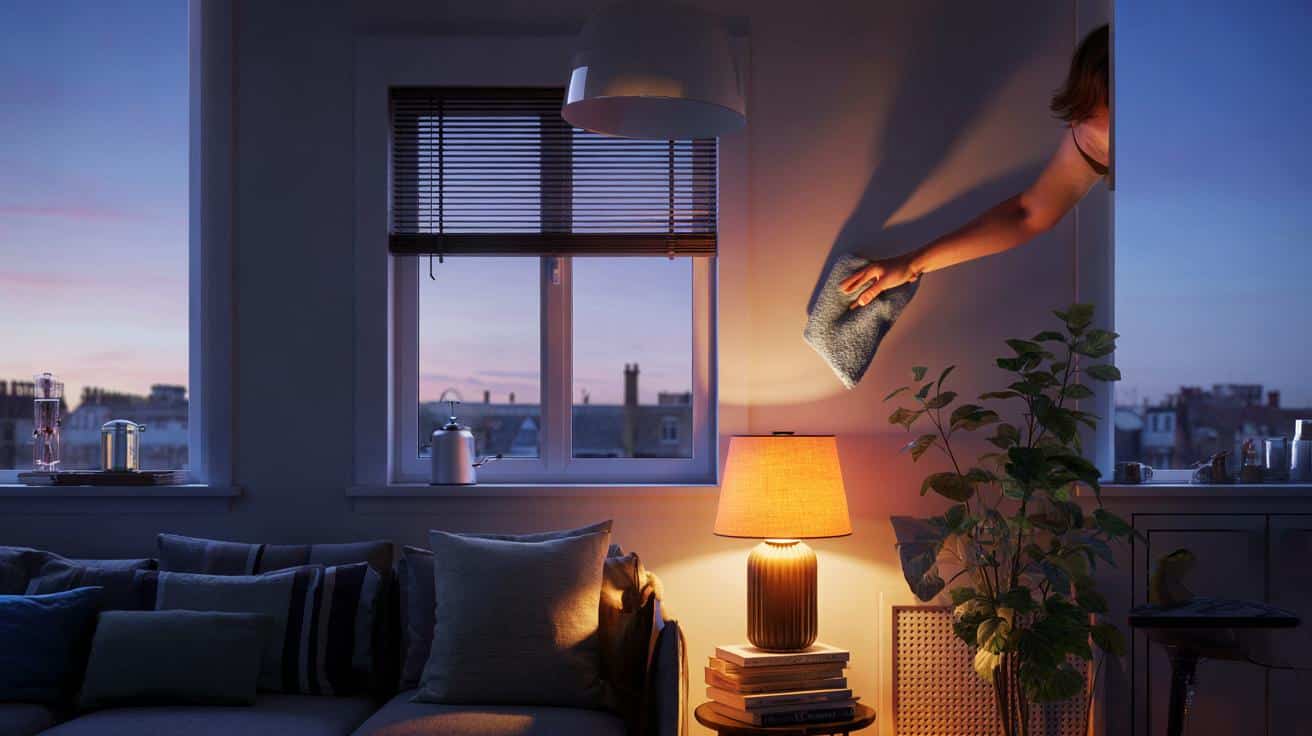The culprit hides in plain sight: the way light lands on your walls and across your face. Change that light for three minutes a day and the room—and your head—start behaving differently. No rewiring. No shopping list. Just a tiny ritual that shifts the day’s weather inside.
I’m writing this at 5:07 p.m. in a small London flat as the sky bruises from blue to mauve. The overhead pendant makes the table look like stage scenery, so I flick it off and tug the blind slats up a notch. A low lamp wakes in the corner. The light skims the books, catches the rim of a cup, and the place exhales a fraction. I wipe the dust ring on the shade with the corner of my T-shirt. Warmth returns to the wallpaper, and the screen glare stops shouting. Three minutes and the room is kinder. Something else has shifted too. A little mystery in the margins.
The quiet power of light you can feel
Light sets the emotional weather of a room. Sideways light softens faces and makes corners feel like places, not leftover space. Top-down glare does the opposite, flattening detail and your energy with it.
We’ve all had that moment when the telly ends, the big light snaps on, and everyone looks tired in an instant. In photos, a window at your side makes you look human; the flash dead-centre makes you look like a passport. Rooms are the same. Where light comes from matters more than how much you have.
Your brain reads light as a signal. Bright, cool light says get moving; low, warm light says settle. Put the wrong message in the wrong hour and you’re working against your body. Place light to wash walls and bounce off ceilings and a room grows in depth even if nothing else changes. That’s the magic trick here: control the direction for calm, not just the wattage for brightness.
The little ritual: the 3-minute light reset
Here’s the habit: **the 3-minute light reset**. Do it once in the morning, once before dusk. First minute, deal with daylight. Throw curtains wide, then tilt blinds upwards so slats face the ceiling. That pushes light onto the top third of your walls, brightening the room without stabbing your eyes.
Second minute, set your anchors. Kill the harsh overheads and switch on one warm lamp at shoulder height. If you’ve got a dimmer, slide it low and kind. No dimmer? Use a lower-lumen, 2700–3000K bulb. Aim the lamp so its light grazes a wall or a plant rather than pointing straight at the sofa. Things look instantly more expensive.
Final minute, clean and aim. Swipe the top of the lampshade and the bulb with a microfibre—dust can steal a surprising chunk of brightness. Nudge a lampshade to remove that awkward tilt. Open a door to borrow light from a brighter hallway, or close it if that spill is too cold. Small moves, big mood.
Proof in real rooms
On a grey Tuesday, I tried the reset in a rented studio where the kitchen lives in the lounge. The overhead made the worktop look harsh and the sofa look sad. We tilted the blinds up and brought a small lamp onto a stack of books by the armrest. The walls glowed. The kettle steam looked cinematic. The tenant, a junior nurse on shifts, said the room “finally felt like it had a good face.”
There’s data behind the feeling. Swap a dusty shade for a clean one and you can recover a chunk of lost lumens—industry folks talk about 10–20% gains just from removing grime. Warmer bulbs in the evening tend to ease the “I’m still at work” buzz. Point light at surfaces, not eyeballs, and you reduce squinting and screen glare without sitting in the dark.
Look at your room like a photographer. You want three layers: ambient light that breathes, task light where you do things, and accent light for charm. The reset sets those layers without a shopping spree. Direct sun? You bounce it. Harsh pendant? You soften it with a shade or turn it off. It’s a small choreography that teaches the space how to treat you.
Common missteps, easy wins
Most mistakes start with height and colour. Lights at ceiling level bleach everything; lights at eye or waist height shape it. Cool-white bulbs (4000–6500K) are brilliant over chopping boards, not brilliant by a bed. If a corner feels dead, it probably needs a lamp pointing at a wall, not another overhead.
Clutter steals light twice: it blocks windows and it creates dark shadows that make the room feel tighter. Clear the top 20 cm of window sills. Pull furniture slightly off the wall so light can travel behind and erase those black edges. Let’s be honest: no one really does this every day. Tie the habit to something you always do—kettle on, lights reset; teeth brushed, lamps sorted.
Designers are blunt about this.
“Light is the paint that never dries,” says London lighting consultant Maya Fox. “You don’t need more of it. You need it in the right place, at the right time.”
- Morning: blinds tilted up, overheads gentle, cool-neutral in the kitchen.
- Evening: overheads off, one **warm anchor lamp** on, light grazing walls.
- Weekly: quick shade and bulb wipe; it keeps brightness honest.
- Always: think sideways light before bright light.
Make it stick without trying
Habits that last ride on habits you already have. Put a microfibre cloth next to the kettle so the wipe becomes muscle memory. Name one lamp your evening signal and put it on a simple plug-in timer for 6 p.m. That way the room starts winding down even if your inbox doesn’t.
*A small ritual, big return.* Track the feeling for a week—two words in your notes each night: “calm” or “wired.” If “wired” turns up when the overheads are blazing, that’s your clue. If “calm” follows the warm lamp, that’s your map. Share the reset with anyone who shares your sockets, or make it your quiet thing as the light slips off the rooftops.
| Point clé | Détail | Intérêt pour le lecteur |
|---|---|---|
| Tilt blinds upward | Angle slats to bounce daylight onto ceilings and upper walls | Softer light without losing brightness; rooms feel taller |
| One warm anchor lamp | 2700–3000K bulb at shoulder height, grazing a wall | Instant cosiness and reduced glare for screens and faces |
| Weekly wipe | Quick microfibre on bulbs and shades to cut dust film | Recovers lost lumens and keeps colours true with no spend |
FAQ :
- What bulb temperature should I pick for evenings?Go warm: 2700–3000K. It flatters skin and signals “wind down” to your brain. Save cooler light for kitchens and desks in daylight hours.
- I rent and can’t install dimmers. Any workaround?Use lower-lumen bulbs in evening lamps, fabric shades, and plug-in dimmer leads. A lamp at the wall with a **soft, low setting** beats a bright ceiling light every time.
- My room has no window. Will the reset still help?Yes. Treat a wall as your “fake window.” Aim a lamp at it to create a glow, then add a second light for tasks. You’re recreating direction, not chasing raw brightness.
- How bright should a living room bulb be?For ambient lamps, 400–600 lumens is plenty when placed well. For reading, go 700–900 lumens with a shade or a bounce so it doesn’t stab your eyes.
- Will this bump my energy bill?Not much. You’re swapping one harsh pendant for focused, efficient LEDs. Because the light lands where you need it, you often use fewer watts and feel better doing it.








